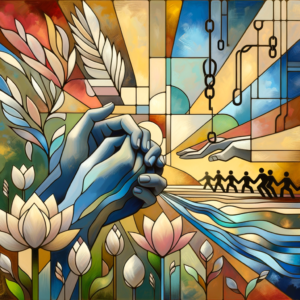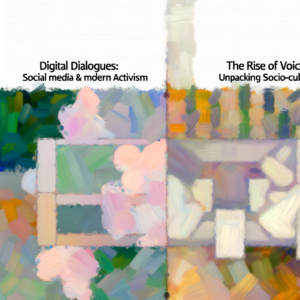> Part 1 of the The Rise of Voices: Unpacking Socio-Cultural Movements series
As the world becomes increasingly interconnected, the struggle for human rights transcends national boundaries, drawing individuals and organizations into a collective fight against injustice. This inaugural piece of our series, “The Rise of Voices: Unpacking Socio-Cultural Movements,” delves into the evolution and impact of the transnational human rights movement—a bastion of hope for those seeking justice in a myriad of socio-political landscapes.
The bedrock of this movement can be traced back to the mid-20th century when the Universal Declaration of Human Rights (UDHR) laid a foundational charter for the rights of individuals everywhere, regardless of their nationality. This monumental document, emerging from the ashes of World War II, heralded a new era of international cooperation aimed at safeguarding human dignity. But, in the years following its adoption, the UDHR became more than a symbol; it became a rallying cry for activists worldwide.
Today, organizations like Amnesty International and Human Rights Watch—not just mere entities but beacons of advocacy—have propelled the human rights agenda across continents. Through tenacious campaigning and strategic lobbying, they have succeeded in bringing issues such as freedom of expression, the abolition of torture, and the rights of refugees into the global spotlight. These organizations epitomize transnational activism’s power: the ability to transcend borders, galvanize grassroots movements, and enact sweeping policy changes.
What sets the contemporary human rights movement apart is its intricate web of interconnected advocacy. Activists leverage digital platforms to create global networks, allowing for real-time collaboration and mobilization. For instance, social media campaigns have proven invaluable in raising awareness and pressure against government-led atrocities, demonstrating the formidable synergy between traditional advocacy tools and digital technology.
However, the path to human rights is fraught with challenges. Cultural diversity and political resistance often stymie efforts to implement universal standards, posing pressing questions about respect for sovereignty versus international intervention. Moreover, opponents often accuse the movement of imposing Western values on non-Western societies, igniting debates about cultural relativism’s role.
Despite these obstacles, the transnational human rights movement continues to inspire change, pushing the boundaries of what is possible. It serves as a testament to the tenacity of the human spirit, illustrating how collective action, driven by a shared commitment to justice, can inspire transformative change on a global scale.
As we embark on this exploration of socio-cultural movements shaping our world, we are reminded of the enduring power of human rights advocacy. The lessons learned here are vital, not just within geographical confines but as an integral part of our shared human heritage. With each campaign, each victory, and each setback, the movement teaches us that the fight for human dignity knows no borders—and it’s a fight worth waging, for the world we envision is one where everyone, everywhere, enjoys the full spectrum of rights.
Stay tuned for the subsequent articles in our series as we examine environmental movements, LGBTQ+ activism, and digital dialogues reshaping societal landscapes in the 21st century.
Recent Posts songplode socio-cultural movements
- Grassroots to Global: The Environmental Advocacy MovementEnvironmental advocacy has evolved from grassroots to global prominence, intertwining activism, culture, and policy. It champions ecological justice, with youth activism reinvigorating discussions on climate action and sustainability.
- Threads of Liberation: Women’s Rights Movements Around the WorldExplore the dynamic journey of women’s rights movements from suffrage campaigns to modern feminism. This analysis highlights cultural impacts, intersectionality, and the continuous quest for true gender equality, inspiring societal change.
- Restoring Dignity: The Global Fight Against Racial OppressionThe enduring fight against racial oppression reflects a tapestry of resilience and unity, as highlighted by the anti-apartheid and Civil Rights movements. These historical struggles inspire today’s global activism, fostering accountability and equity through modern platforms like Black Lives Matter. As we explore these legacies, we seek to understand their lasting impact on societal narratives of justice and equality.
- Digital Dialogues: Social Media and Modern ActivismIn today’s digital age, activism is redefined through the power of social media, offering vast possibilities for engagement and global reach. However, challenges like misinformation and “slacktivism” pose significant hurdles.














